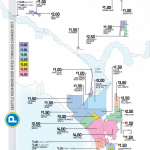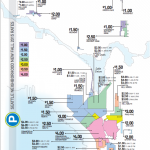Seattle takes a very data-driven approach to paid parking rates and restrictions throughout the city. Each year, the Seattle Department of Transportation (SDOT) conducts a series of detailed parking studies wherever paid parking is in effect and makes adjustments accordingly. New rates and regulations are determined in the summer and put into effect the following fall. This year is no exception.
SDOT will make changes to 16 parking subareas beginning in September and continuing through the end of the year. For most of these subareas, rates will be increased and decreased depending upon demand patterns while a few will see paid parking hours adjusted. But perhaps the biggest change that SDOT will make this year is full-scale implementation of time of day (TOD) paid parking. Harnessing new technologically advanced parking pay stations, SDOT will be able to charge different parking rates depending upon the hour.
Background and methodology
SDOT manages paid parking in 16 neighborhoods and 29 subareas across Seattle. In total, 11,890 parking spaces are part of the paid parking program. The City doesn’t typically mark parking spaces, but does take an inventory of how many theoretical spaces are available on each blockface. This is done by estimating standard on-street parking sizes and accounting for right-of-way constraints (e.g. distances from stop signs and fire hydrants). Paid parking is managed by charging hourly rates and enforcing strict time limit regulations. Hourly parking rates range anywhere from $1.00 to $4.00 per hour while parking time limits vary from 2 hours to 10 hours. Most areas where paid parking is enforced only have paid parking from 8am to 5pm Monday through Saturday. Although, in recent years, SDOT has extended paid parking until 8pm in certain neighborhoods.
Survey data is collected by SDOT for each neighborhood on an annual basis. This year, the data was collected between March and May, in keeping with previous years. The only exceptions to this were Ballard and Pioneer Square where SDOT held off on data collection until July (this data has not yet been released). The decision to wait for both neighborhoods was the result of recent paid parking changes (deploying new pay parking in parts of the Ballard Core and replacement of pay stations in Pioneer Square). Data was typically collected on weekdays (Tuesday, Wednesday, and Thursday) to capture average parking utilization across each subarea. Most survey observations were made from 8am to 9pm hourly, although SDOT continued counting until 12am in a few neighborhoods.
Managing supply and demand
The paid parking program is managed on the basic principles of supply and demand. With a limited number of available parking spaces and inconsistent demand throughout areas and time, SDOT uses price and time limits to manage how consumers choose to occupy space and smooth out utilization. There are a number of practical reasons for managing parking in this way:
- Help users find parking easily within a close walking distance of their intended destination(s);
- Turnover of spaces so that other users can access an area for business and boost economic activity;
- Reduce traffic congestion, wear and tear, and noise resulting from vehicles circling for parking spaces; and
- Conserve fuel and reduce vehicle emissions in the search for parking.
With this in mind, SDOT’s primary goal of the paid parking program is to maintain an average of one to two open parking spaces per blockface throughout the day. This typically translates to 70% to 85% parking utilization, a key metric for SDOT.
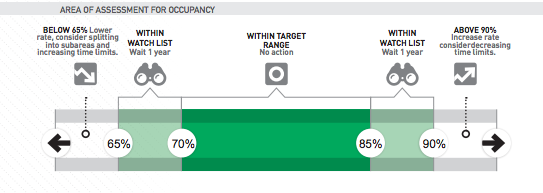
Each subarea is assessed on the same parking utilization rubric (shown above) and can be summarized as follows:
- Parking utilization rates between 70% and 85% are within the target range, meaning that no changes are necessary to manage parking.
- When parking utilization is below 65%, SDOT may consider lowering hour parking rates, increasing time limits for parking, decrease hours of paid parking regulations, and/or breaking up subareas to have different parking rules.
- When parking utilization is above 90%, SDOT may consider increasing hour parking rates, decreasing time limits for parking, add hours of paid parking regulations, and/or breaking up subareas to have different parking rules.
- Between 65%-70% and 85%-90% parking utilization, a subarea is placed on the “watch list” for one year. This means that no formal changes are enacted in the immediate year, but could in the following if parking utilization doesn’t move closer to the target range (70% to 85%).
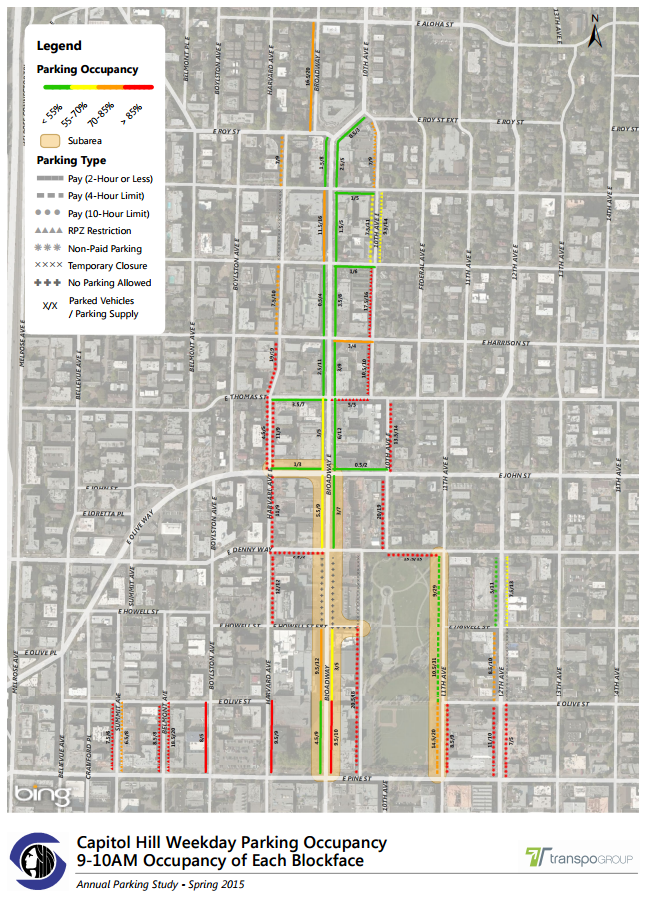
Digging deeper into the parking studies reveals an extensive suite of subarea analysis. SDOT conducts a meticulous review of each blockface by first inventorying how many parking spaces a curb side can hold and then categorizing them based upon their parking regulations (pay 2hr/4hr/10hr, Restricted Parking Zoning, temporary closure, etc.) Average occupancy for each blockface is then determined by multiple rounds of data collection from the same hourly time periods. Comparing this average number to the theoretical maximum, SDOT can derive total subarea parking utilization across all time periods or specific ones (morning, afternoon, and evening).
Time of day paid parking
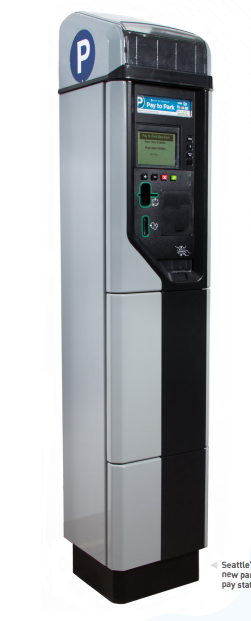 Time of day (TOD) paid parking is already up and running in the Pioneer Square and Chinatown/International District Core subareas thanks to the installation of new pay stations. SDOT plans to implement TOD paid parking next in Downtown Commercial Core subarea beginning in September, although rolling deployment will continue through the end of year in Chinatown/International District Edge, Capitol Hill, and South Lake Union, pending installation of the new pay stations. While no other subareas beyond these are planned for TOD paid parking in 2015, SDOT is quickly working to deploy the new pay stations on a neighborhood-by-neighborhood basis. That means 1,500 electronic pay stations are slated to get an upgrade by the end of 2016.
Time of day (TOD) paid parking is already up and running in the Pioneer Square and Chinatown/International District Core subareas thanks to the installation of new pay stations. SDOT plans to implement TOD paid parking next in Downtown Commercial Core subarea beginning in September, although rolling deployment will continue through the end of year in Chinatown/International District Edge, Capitol Hill, and South Lake Union, pending installation of the new pay stations. While no other subareas beyond these are planned for TOD paid parking in 2015, SDOT is quickly working to deploy the new pay stations on a neighborhood-by-neighborhood basis. That means 1,500 electronic pay stations are slated to get an upgrade by the end of 2016.
So far, SDOT is only using TOD in hourly blocks–morning, afternoon, and evening–and in selected locations. But the technology does have the capability to be even more dynamic. SDOT hopes that by charging different rates at different hours, parking utilization will get closer to the targeted equilibrium. Once the pay stations are installed in all neighborhoods, SDOT will be able to fine tune pricing beyond the current blunt rate structure.
Examples from the 2015 parking studies
The Belltown South serves as a great example of a study area that won’t see parking rate and regulation changes in 2015. SDOT’s 2015 parking study showed that parking utilization for all time periods (morning, afternoon, and evening) were up year-over-year. Evening hours (6pm to 7pm) saw a 19% jump in parking utilization while morning hours (9am to 10am) saw a modest upward change by 2%. Only the morning hours remain slightly below the target parking utilization. But together, the data puts average parking utilization well within the 70%-85% window. SDOT plans to keep the same pay parking regulations from Summer 2015 in force over the next year.
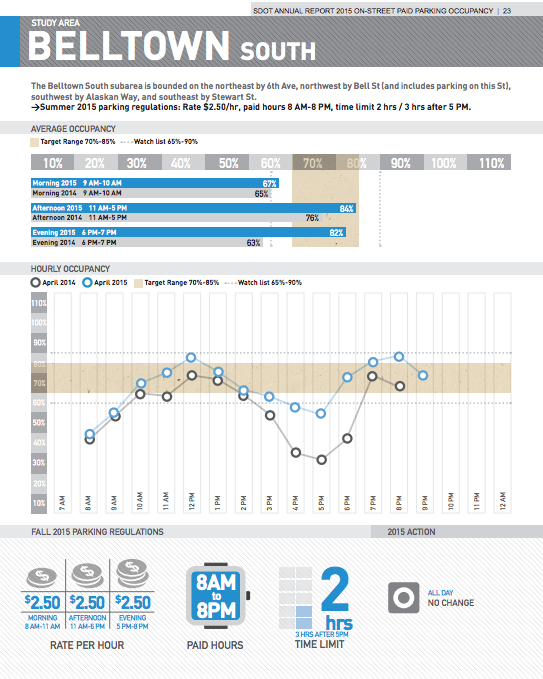
Meanwhile, the Chinatown/International District Core subarea will get expanded time of day pricing. This is because parking utilization is all over the board. Morning utilization is well below the target range at 53% while afternoons and evening exceed it by more than 6%. SDOT has opted for hourly parking rates changes with a drop in the morning and increases in the afternoon and evening time periods.
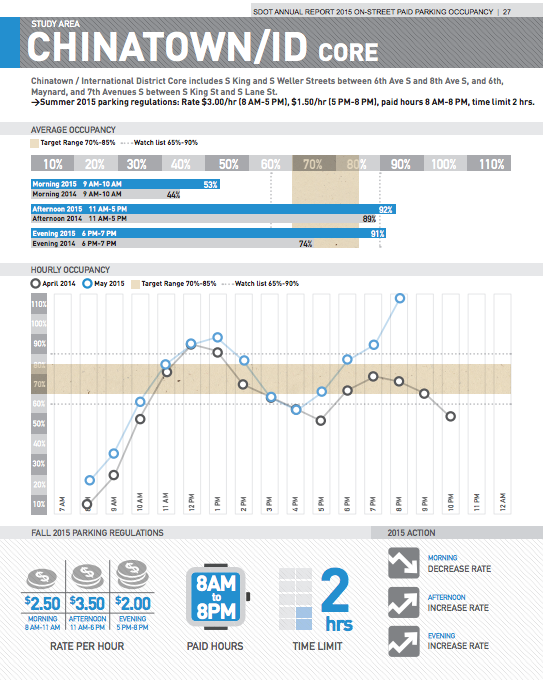
Summary of changes for 2015
Aside from the rate map, SDOT put together a simple summary of the changes as follows:
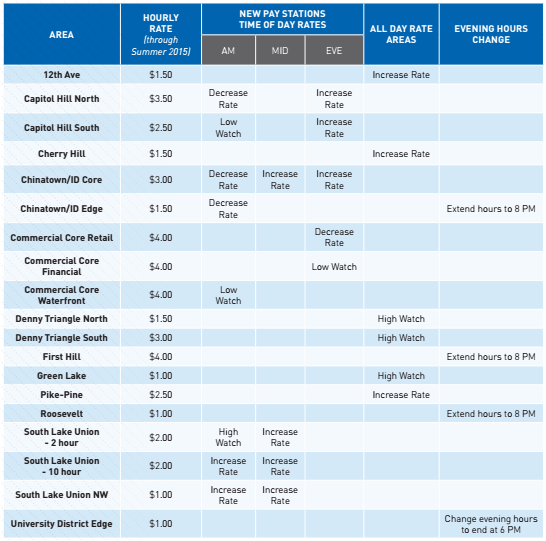
But for those wanting the detailed list of changes, here’s what SDOT is planning for paid parking in Fall 2015:
-
- Ballard: Data is forthcoming in all Ballard subareas; no decisions have been made yet on potential changes, although the Ballard Locks are a likely candidate.
-
- Capitol Hill North: Afternoon hours remain at $3.50 per hour, but mornings decrease to $3.00 and evenings increase to $4.00.
-
- Capitol Hill South: Morning and afternoon hours remain at $2.50 per hour, but evenings increase to $3.00 per hour.
-
- Pike-Pine: Rates increase from $2.50 to $3.00 per hour.
-
- 12th Avenue: Rates increase from $1.50 to $2.00 per hour.
-
- Cherry Hill: Rates increase from $1.50 to $2.00 per hour.
-
- Chinatown/International District Core: Rates decrease in the morning from $3.00 to $2.50 per hour, afternoon rates increase from $3.00 to $3.50 per hour, and evening rates increase from $1.50 to $2.00 per hour.
-
- Chinatown/International District Edge: Afternoon and evening hours remain at $1.50 per hour, but morning rates decrease from to $1.00 per hour. Paid parking hours are extended until 8pm due to high parking utilization.
-
- Downtown Commercial Retail Core: Morning and afternoon hours remain at $4.00 per hour, but evenings decrease to $3.50 per hour.
-
- First Hill: Paid parking hours are extended until 8pm due to high parking utilization.
-
- Roosevelt: Paid parking hours are extended until 8pm due to high parking utilization.
-
- Pioneer Square Core: Paid parking is dropped between the hours of 5pm and 6pm due to lack of high parking utilization.
-
- Pioneer Square Edge: Paid parking is dropped between the hours of 5pm and 6pm due to lack of high parking utilization.
-
- South Lake Union Northwest: Rates increase from $1.00 to $1.50 per hour.
-
- South Lake Union 10hr: Rates increase from $2.00 to $2.50 per hour.
-
- South Lake Union 2hr: Rates remain at $2.00 in the morning per hour, but afternoon and evening rates increase to $2.50 per hour.
- University District Edge: Paid parking is dropped between the hours of 6pm and 8pm due to lack of high parking utilization.
For the full block-by-block parking utilization studies, please see the following (not all 2015 studies have been posted yet): Ballard Locks, Belltown, Capitol Hill, Cherry Hill, Chinatown/International District, Commercial Core, Denny Triangle, First Hill, Fremont, Green Lake, Pike-Pine, Roosevelt, South Lake Union, Uptown, Uptown Triangle, and 12th Avenue (Capitol Hill).
Stephen is a professional urban planner in Puget Sound with a passion for sustainable, livable, and diverse cities. He is especially interested in how policies, regulations, and programs can promote positive outcomes for communities. With stints in great cities like Bellingham and Cork, Stephen currently lives in Seattle. He primarily covers land use and transportation issues and has been with The Urbanist since 2014.


